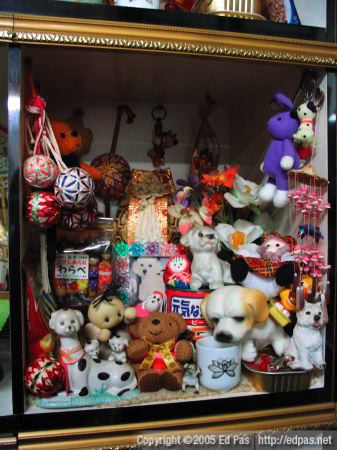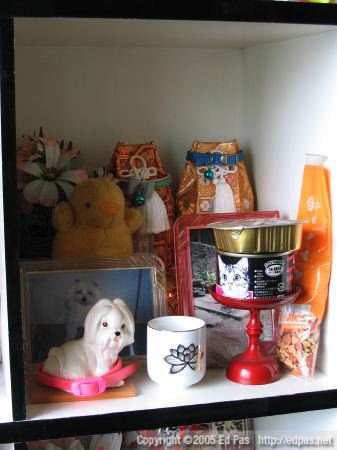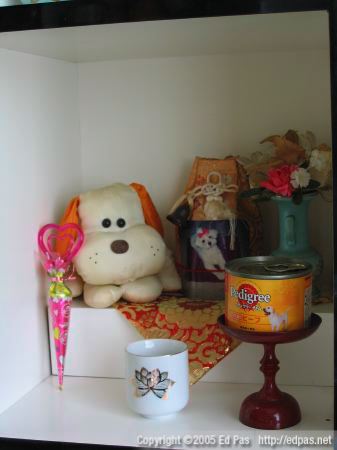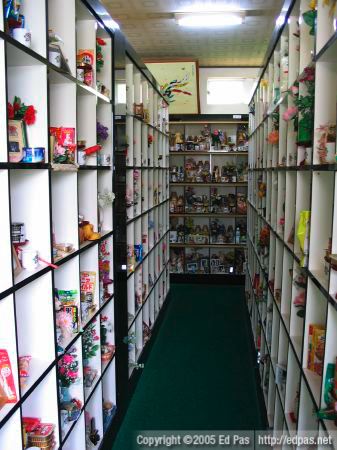In this second story about my April 30, 2005 cycling and hiking day trip through rural Kitakyushu, we’ll go explore a temple complex that I can’t find anywhere on my map. Though as you’ll soon find out it turns out to not be a temple complex after all.
While this post stands on its own, if you haven’t read the introduction or first story (about snakes), I suggest that you read them first so you’ll understand the context.
I was a bit confused after I passed the “beware of snakes” sign and the overflow parking lot, and entered the main temple grounds. Things were set up in a different way than what I’ve come to expect in Japanese Buddhist temple layout. The buildings themselves also looked different. Next to the parking lot there was an office. Nothing strange there. A large hall-type building sat about thirty steps up one hill. It was unremarkable—something Buddhist hall-ish looking, but with a lot of unpainted concrete rather than the usual fine woodwork—so I took pictures of the bamboo grove beyond it instead. In a slightly different direction uphill about fifty metres from the office were a few smaller structures. There were also a couple of small park areas, a graveyard, and a few statues.
These are all things that I’ve seen at other temples but as I said, they were different here. For example, the graveyard was the centrepiece, rather than tucked away in a hidden corner. There were also three or four people in navy uniforms sweeping the grounds. I rarely see people working at temples unless there’s a festival, but at this relatively early hour—9:30 in the morning, a time I rarely go to temples—I figured they were just preparing for the day’s visitors. As I’ve said many times before, my language skills aren’t up to anything as technical as discussing religious architecture, especially in the morning. So instead of asking questions, I wandered around snapping pictures, followed at a discreet distance by one of the ladies in blue.
After exploring the grounds, I went into a building with decor inside that made me think “art installation.” Here’s a wall of colourful curios:

On closer inspection, I realized that each cubby was an altar to one or more deceased pets. Yes, rather than a temple, it dawned on me that this place was a crematorium, columbarium, and cemetary for pets.
Here’s a detail of a section of one row:

Here are four shots of individual altars. The first appears to be dedicated to a single dog, one who evidently loved plush toys.

The next is in honour of a dog and a cat. I could make a joke about dogs and cats and cohabitation but I think everyone would agree that it’d be in bad taste.

Next, another single dog, this time a little less materialistic.

I think that the packages with the elaborate embroidery and the knotted white string contain the pet ashes. Tucked in a far corner were some low shelves filled with just the ash containers but without accoutrements. The lighting was poor so none of my photos of them turned out so you’ll have to take my word for it that they looked a little crowded.
Here’s one final cubby, with a single canine tenant:

To give a sense of what the building interior looks like as a whole, and to give a sense of how many cubbies there are, here are two more views from inside. The first one is from one wall, looking down the length of an aisle:

And with this second one I was standing in a front corner, looking across the length of the building past the entrance. I’d guess that there are about nine hundred individual compartments in total.

Finally, an exterior view from the bottom of the graveyard. I’m not sure what the building on the left side is, but the one on the right, hiding behind the tree, is the columbarium. Out of the frame, to the left and down some steps, was a building with a couple of tall chimneys sticking out the top, and what I think was cremation equipment inside.

Finding a recently deceased snake, and then immediately encountering a place where people’s companion animals were memorialized was strange indeed. Even though I know how much a lot of people—and not just in Japan—cherish the animals in their lives, thinking and writing about this experience—even looking at the photos—still makes me shake my head and wonder if it was real.
[The next post in this series is Rural Kitakyushu: I Hope You Like Frogs]